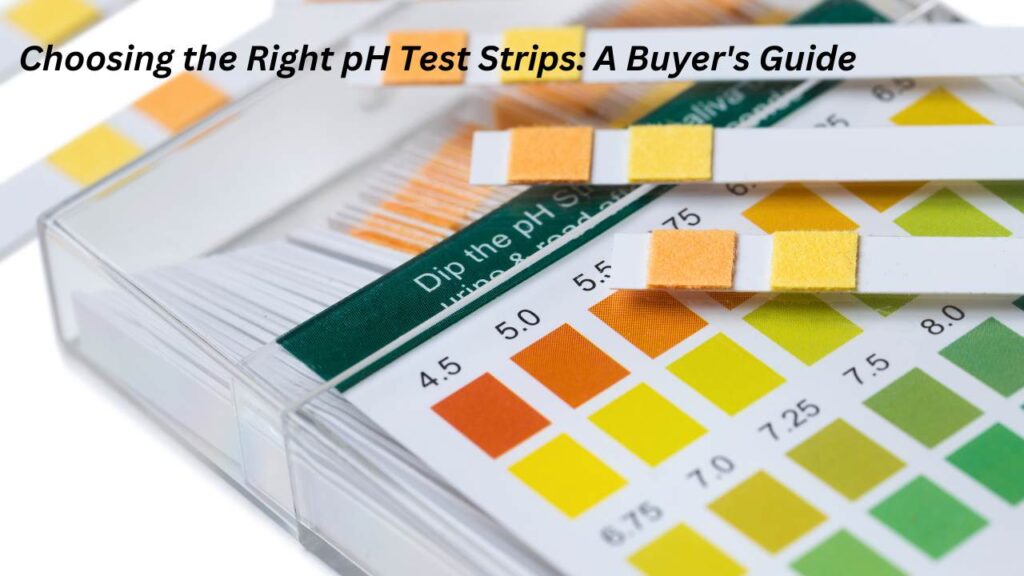When it comes to maintaining proper pH levels, whether for health, gardening, or scientific purposes, choosing the right pH test strips is essential. The market offers a wide variety of pH test strip, each designed for specific applications. This comprehensive buyer’s guide will help you navigate the options and select the best pH test strip for your needs.
Introduction
Understanding the importance of pH levels and having accurate pH test strips can make a significant difference in various fields. From monitoring soil conditions in gardening to ensuring water quality in aquariums, pH testing plays a crucial role. This guide provides detailed insights into the types of pH test strips, their applications, and tips on choosing the best ones.
Understanding pH and Its Importance
pH, which stands for potential of hydrogen, is a measure of how acidic or alkaline a solution is on a scale of 0 to 14. Maintaining the correct pH balance is vital for numerous applications:
- Health and Wellness: pH levels in the human body can affect overall health, with certain conditions benefiting from monitoring pH.
- Gardening and Agriculture: Soil pH affects nutrient availability and plant growth.
- Aquariums and Pools: Proper pH levels ensure a safe environment for aquatic life.
- Scientific Research: Accurate pH measurements are crucial in various laboratory settings.
Types of pH Test Strips
Choosing the right pH test strips depends on the intended application. Here are the main types:
Litmus Paper Strips
Overview: Litmus paper is a simple, quick, and cost-effective way to test pH. It changes color when dipped in a solution, indicating whether the solution is acidic or alkaline.
Pros:
- Easy to use
- Inexpensive
- Quick results
Cons:
- Not very precise
- Limited to indicating general pH range (acidic or alkaline)
Universal Indicator Strips
Overview: Universal indicator strips are more advanced than litmus paper, offering a broader range of pH measurement with distinct color changes for each pH unit.
Pros:
- Provides a wider pH range
- More precise than litmus paper
- Easy to interpret with color chart
Cons:
- Slightly more expensive
- May require more careful handling
Also Read: 36.7 Celsius Is What In Fahrenheit ?
Narrow Range pH Strips
Overview: Narrow range pH strips are designed for specific applications requiring high precision. They cover a smaller pH range but provide more detailed readings.
Pros:
- High accuracy within a specific pH range
- Ideal for specialized applications
- Clear, precise color changes
Cons:
- Limited to a specific pH range
- Can be more expensive
Digital pH Meters
Overview: While not technically pH strips, digital pH meters are a popular alternative for high-precision pH measurement. They use a probe to measure pH and provide a digital readout.
Pros:
- Highly accurate
- Easy to read digital display
- Reusable and durable
Cons:
- More expensive than pH strips
- Requires calibration and maintenance
Factors to Consider When Choosing pH Test Strips
When selecting pH test strips, consider the following factors to ensure you choose the right product for your needs:
Accuracy and Precision
Importance: Accuracy and precision are crucial for reliable pH measurement. Choose test strips that provide clear, precise results suitable for your application.
Application Specificity
Importance: Different applications require different levels of accuracy and pH range. Ensure the test strips you choose are designed for your specific use case.
Ease of Use
Importance: The test strips should be easy to use and interpret, especially if they will be used frequently or by individuals without a scientific background.
Cost
Importance: Consider the cost of test strips in relation to their accuracy and durability. While more expensive strips may offer better precision, ensure they fit within your budget.
Shelf Life and Storage
Importance: Check the shelf life of the test strips and any specific storage requirements to ensure they remain effective over time.
Top Brands of pH Test Strips
To help you get started, here are some reputable brands known for producing high-quality pH test strips:
VWR
Overview: VWR is a trusted name in scientific supplies, offering a wide range of pH test strips suitable for various applications.
Pros:
- High accuracy and reliability
- Widely available
- Suitable for both professional and home use
Cons:
- Can be pricier than other brands
Hydrion
Overview: Hydrion is known for its user-friendly pH test strip, offering both universal and narrow range options.
Pros:
- Easy to use
- Affordable
- Accurate color changes
Cons:
- Limited availability in some regions
Micro Essential Laboratory
Overview: Micro Essential Laboratory provides high-precision pH test strip, ideal for laboratory and specialized use.
Pros:
- High precision and accuracy
- Wide range of pH test strip
- Trusted by professionals
Cons:
- Higher cost
Applications of pH Test Strips
pH test strip have a wide range of applications across different fields. Here are some of the most common uses:
Health and Wellness
Description: Monitoring pH levels in the body can help in diagnosing and managing various health conditions. pH test strip are often used to test saliva and urine pH.
Gardening and Agriculture
Description: Soil pH testing is crucial for optimizing plant growth and nutrient availability. Gardeners and farmers use pH test strip to ensure their soil conditions are ideal.
Aquariums and Pools
Description: Maintaining proper pH levels in aquariums and pools is essential for the health of aquatic life and the safety of swimmers. pH test strip provide a quick and easy way to monitor water quality.
Scientific Research
Description: pH test strips are a staple in laboratories, used for a variety of experiments and research purposes. Their precision and ease of use make them a valuable tool for scientists.
How to Use pH Test Strips
Using pH test strips correctly is essential for obtaining accurate results. Here is a step-by-step guide:
Step-by-Step Instructions
- Collect Sample: Gather a small sample of the liquid you want to test. This could be water, soil solution, saliva, or any other liquid.
- Dip the Strip: Dip the pH test strip into the sample for the recommended amount of time, usually a few seconds.
- Remove and Wait: Remove the strip from the sample and wait for the color to develop. This usually takes a few seconds to a minute.
- Compare Colors: Compare the color on the strip to the provided color chart to determine the pH level.
- Record Results: Record the pH reading for future reference or analysis.
Tips for Accurate Testing
- Follow Instructions: Always follow the manufacturer’s instructions for the best results.
- Use Fresh Strips: Ensure that the test strips are fresh and have not expired.
- Avoid Contamination: Avoid touching the test area of the strip with your fingers to prevent contamination.
- Store Properly: Store test strips in a cool, dry place to maintain their effectiveness.
Common Mistakes to Avoid
- Using Expired Strips: Expired test strips can give inaccurate results.
- Improper Storage: Storing strips in humid or hot conditions can degrade their accuracy.
- Incorrect Dipping Time: Not following the recommended dipping time can lead to incorrect readings.
Frequently Asked Questions
What are pH test strips used for?
pH test strip are used to measure the acidity or alkalinity of a solution. They are commonly used in health and wellness, gardening, aquariums, pools, and scientific research.
How do I choose the best pH test strips?
Choose pH test strip based on your specific application, considering factors such as accuracy, precision, ease of use, and cost. Look for reputable brands and read product reviews to ensure quality.
Can pH test strips expire?
Yes, pH test strip can expire. Always check the expiration date and store them properly to maintain their effectiveness.
How accurate are pH test strips?
The accuracy of pH test strip can vary based on the brand and type. High-quality test strips can provide accurate readings within a specific pH range.
Are digital pH meters better than pH test strip?
Digital pH meters are generally more accurate than pH test strip but are also more expensive and require calibration. pH test strip are a cost-effective and easy-to-use alternative for many applications.
Can I use pH test strips for both liquids and solids?
pH test strip are primarily designed for testing liquids. For solids, such as soil, you will need to create a solution by mixing the solid with water before testing.
Conclusion
Choosing the right pH test strips is essential for accurate and reliable pH measurement. By understanding the types of pH test strip available and considering factors such as accuracy, application specificity, ease of use, cost, and shelf life, you can select the best product for your needs. Whether you’re monitoring health, maintaining a garden, or conducting scientific research, the right pH test strip will ensure you get precise and dependable results.
Also Read: The Connection Between Passiflora and Mental Health



